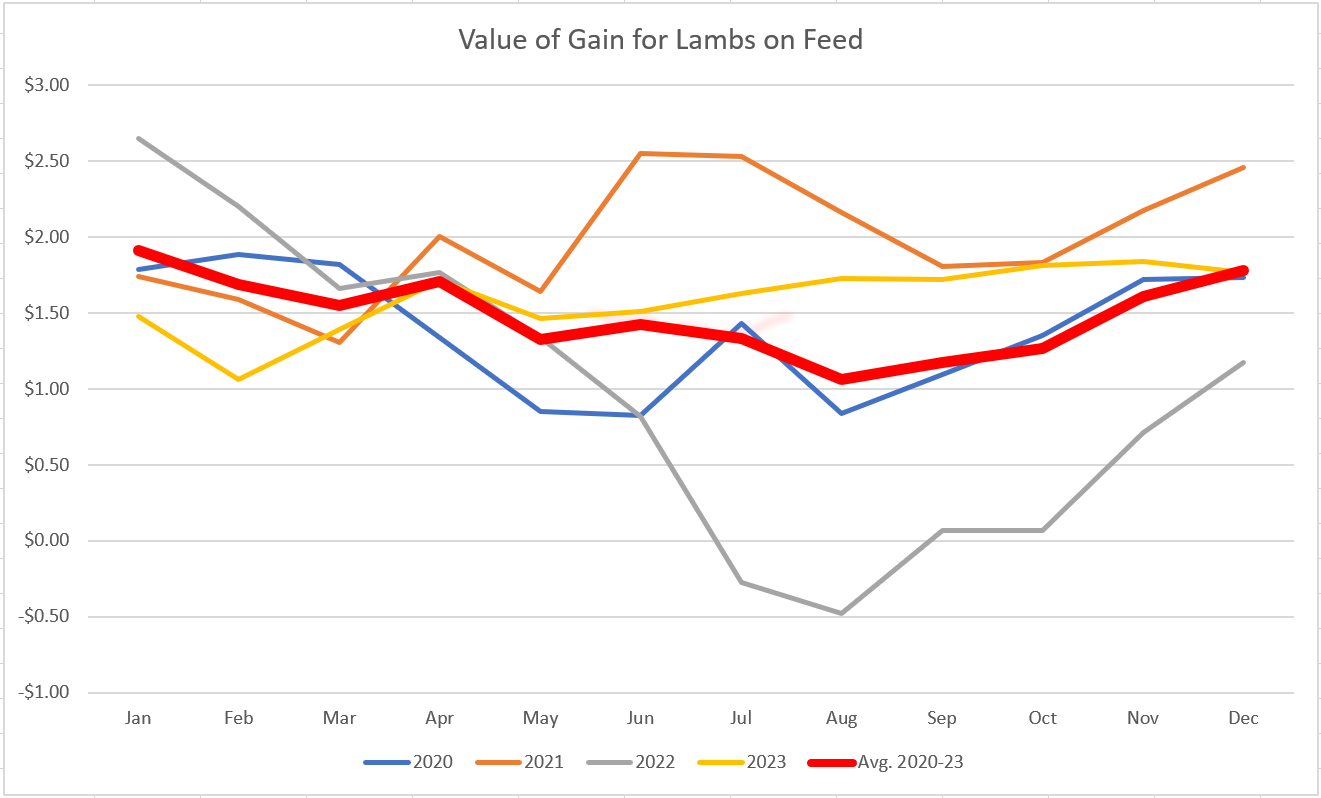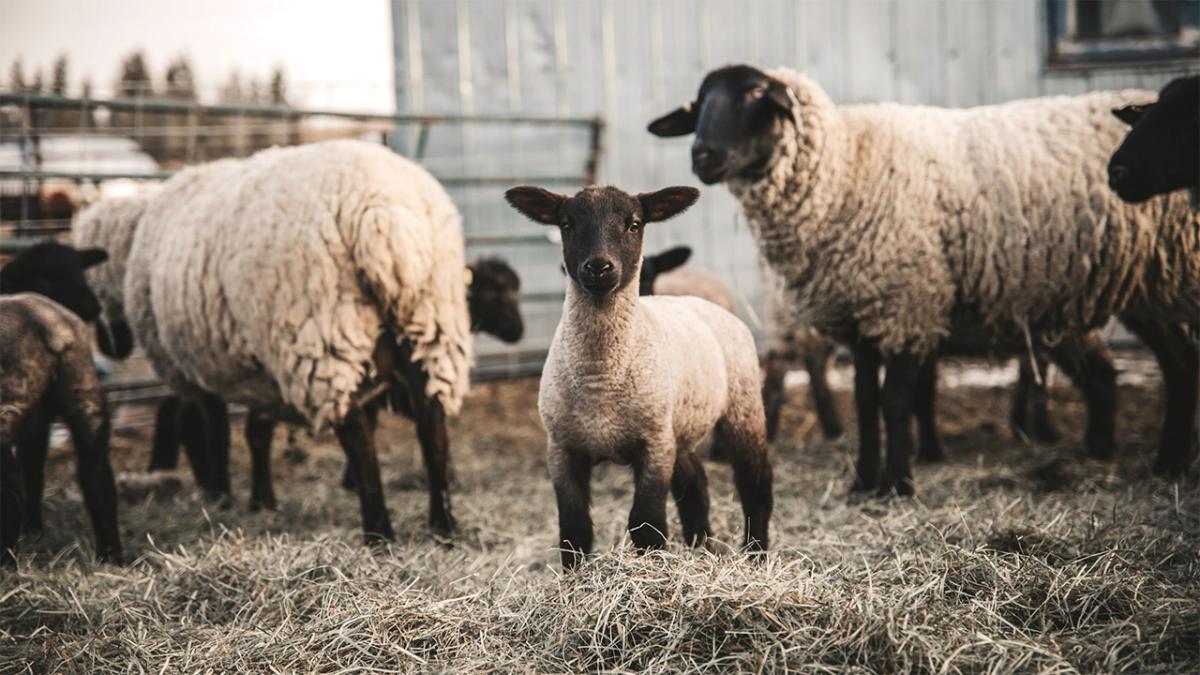Real Ag Stock.
This article was first published as part of the "Cornhusker Economics" series by UNL's Department of Agricultural Economics on March 6, 2024.
Value of gain (VOG) is a term in the livestock feeding industry that refers to the average value of a pound of gain. It is the most appropriate revenue value to use in comparison to the cost of gain to determine profit margin. The formula used to calculate the VOG is:

In summary, the value of gain can be thought of as the change in dollar value for the animal divided by its change in weight. If the weight is in pounds and the price is in dollars per pound, then the value of gain is in dollars per pound. For example, if a 500-pound calf with a market price of $1.80 per pound goes on feed, its beginning value is $900. If it is fed to a weight of 750-pounds and the market price for it at that point is $1.65 per pound, then it gained $337.50 in value (750 x 1.65 – 900). Its VOG would be $1.35 per pound (337.50/250 pounds gained). If the cost of gain for the animal is $1.15 per pound, then the profit margin is $0.20 per pound of gain (1.35 – 1.15) or $50 per head.
Sometimes producers make the mistake of comparing the cost of gain to the projected sale market price when looking at profit margins and making decisions regarding feeding animals. The projected sale market price does not consider the change in market price per pound as the animal gains weight and, thus, comparing it to the cost of gain usually overestimates your profit margin.
The lamb feeding industry is an industry that is interesting to look at but seldom studied in terms of VOG. The average live weight of a slaughtered lamb over the five-year span from 2019-2023 was 128 pounds (Livestock Market Information Center, LMIC). However, many lambs are sold in the 60 to 90-pound range for the nontraditional or ethnic market consumption or for transfer into a feeding situation and eventual traditional market harvest in the 120 to 160-pound range. The LMIC maintains a three-market (CO, SD, TX) average lamb market price series for both 60 to 90-pound lambs and 100 to 150-pound lambs. What follows is a look at the VOG for lambs on feed moving between these two weight classes and finishing in the higher weight class during the four calendar year periods from 2020-2023.
Lambs will gain 0.55 to 0.8 pounds per day depending on stage of growth and the level of concentrates in the ration. Typical feed efficiency rates average 5:1 (5 pounds of feed per 1 pound of gain). Efficiency rates can vary greatly depending upon the stage of growth and the ration mix. Feed efficiency declines as the animal gains weight, but this can be offset by efficiency gains from changing the ration to contain less roughage and more concentrates as the lamb moves through the finishing stages.
If we assume 70 pounds of gain is desired in the feeding phase as the lamb moves from 70 pounds to 140 pounds, a feed efficiency rate of 5:1 implies it will take approximately 350 pounds of feed. If the feed costs $300 per ton on average, this results in a feed cost of approximately $52.50 per head or $0.75 per pound of gain. Fixed costs (i.e. yardage costs) and other miscellaneous charges (i.e. medications, transportation, death loss, etc.) would need to be added to this cost to get the total cost of gain that would need to be covered by the VOG to produce a profit margin.
If we assume 0.7 pounds per day for the average daily gain, the lamb will need 100 days to accumulate 70 pounds of gain. For simplicity, let’s assume 14 weeks on feed. Using the LMIC 3-market average price for 100 to 150-pound lambs for each week in 2020-2023 as the ending price and the LMIC 3-market average price for 60 to 90-pound lambs lagged 14 weeks prior to that for the starting price, the VOG for lamb feeding can be calculated for the four-year period from 2020-2023 (Figure 1). The VOG for lamb feeding ranged from a low of -$1.07 during a market crash in July-August of 2022 to a high of $3.13 in early July of 2021. The average VOG over this time period was $1.51 per pound.
Figure 1: Weekly Value of Gain for Lambs Harvested at 140 pounds, fed from 70 pounds to harvest weight over 14 weeks. Prices obtained from Livestock Market Information Center 3-market average price for CO, SD, and TX for 60 to 90-pound lambs and 100 to 150-pound lambs.

Eighty percent of the lambs born in the U.S. are born in the first five months of the calendar year. Therefore, most of the lambs are weaned in September-October and start entering into feedlots in October-November. The lamb feeding industry in the U.S. is concentrated in northeast Colorado with anywhere from half to three-quarters of the lambs moving through U.S. feedlots in a given year passing through one of the lamb feedlots in northeast Colorado. Colorado lamb feedlot inventories usually peak at around 250,000 head in November and dip to a low around 60,000 head in August. The spring Easter season serves as an important target harvest date for marketing purposes with most of the lamb harvest completed by early summer.
Smoothing out the weekly VOG data into monthly averages produces the seasonal comparison over the four years in Figure 2. Note that the VOG for lambs reaching harvest weight in the March-April peak harvest period was relatively stable compared to other times of the year. This is followed by a highly variable summer period from one year to the next before a general increase in the latter part of the year headed into the holiday season. After peaking at the end of the calendar year, the trend is a gradual decline during the first part of the next year.
Figure 2: Monthly Value of Gain in dollars per pound for Lambs Harvested at 140 pounds, fed from 70 pounds to harvest weight over 14 weeks. Prices obtained from Livestock Market Information Center 3-market average price for CO, SD, and TX for 60 to 90-pound lambs and 100 to 150-pound lambs.

Value of gain captures a comparison between input and output prices for different weight classes of animals over a defined feeding period. Knowledge of the value of gain provides important information about the cost of gain needed to be achieved to consistently produce a profit. For the lamb feeding industry from 2020-2023, an average VOG was estimated to $1.51 and 82 percent of the time the VOG was above $1.00 per pound. The exceptions on the low side were a few weeks during the earlier summer of 2020 right after the COVID pandemic started and a market crash over several weeks in 2022.
Jay Parsons, Professor
Center for Agricultural Profitability
Department of Agricultural Economics
University of Nebraska-Lincoln
